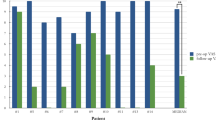Abstract
Objective:
Few characteristics have been identified as risk factors for brachial plexus injuries. We sought to investigate a potential relationship with multiparity based on clinical observation at our institution.
Study Design:
In this retrospective case series, we analyzed all brachial plexus injuries recognized at or after delivery between October 2003 and March 2013 (n=78) at a single academic medical institution. Patient, infant, labor and delivery characteristics were compared for women with and without prior vaginal deliveries.
Result:
Of the 78 injuries, 71 (91%) occurred after a vaginal delivery and 7 (9%) after a cesarean delivery. Of the 71 injuries after a vaginal delivery, 58% occurred in women with a prior vaginal delivery (n=41, 5.7 per 10 000 live births) compared with 42% without a prior vaginal delivery (n=30, 4.0 per 10 000 live births). Multiparous patients had shorter labor courses and fewer labor interventions than nulliparous patients. Providers clinically underestimated the birth weights to a greater extent in multiparas than in nulliparas (median underestimation 590 vs 139 g, P=0.0016). The median birth weight was 4060 g in the multiparous group, which was significantly larger than affected infants born to the nulliparous group (3591 g, P=0.006). The affected infants of the multiparous group were, as expected, significantly larger than their previously born siblings (median 567 g larger, P<0.001).
Conclusion:
Brachial plexus injuries occurred as frequently in multiparous patients as in nulliparous patients. In general, multiparous patients are more likely to have larger infants; however, providers significantly underestimate the birth weight of their infants. The findings of this study should deter providers from assuming that a prior vaginal delivery is protective against brachial plexus injuries.
This is a preview of subscription content, access via your institution
Access options
Subscribe to this journal
Receive 12 print issues and online access
$259.00 per year
only $21.58 per issue
Buy this article
- Purchase on Springer Link
- Instant access to full article PDF
Prices may be subject to local taxes which are calculated during checkout


Similar content being viewed by others
References
Foad SL, Mehlman CT, Ying J . The epidemiology of neonatal brachial plexus palsy in the United States. J Bone Joint Surg Am 2008; 90 (6): 1258–1264.
Mollberg M, Hagberg H, Bager B, Lilja H, Ladfors L . High birthweight and shoulder dystocia: the strongest risk factors for obstetrical brachial plexus palsy in a Swedish population-based study. Acta Obstet Gynecol Scand 2005; 84 (7): 654–659.
Graham EM, Forouzan I, Morgan MA . A retrospective analysis of Erb’s palsy cases and their relation to birth weight and trauma at delivery. J Matern Fetal Med 1997; 6 (1): 1–5.
Ecker JL, Greenberg JA, Norwitz ER, Nadel AS, Repke JT . Birth weight as a predictor of brachial plexus injury. Obstet Gynecol 1997; 89 (5 Pt 1): 643–647.
Task Force of Neonatal Brachial Plexus Palsy. Neonatal Brachial Plexus Palsy [Internet]. American College of Obstetricians and Gynecologists, 2014 [cited 7 May 2014], pp 129. Available from www.acog.org.
Gherman RB, Goodwin TM, Ouzounian JG, Miller DA, Paul RH . Brachial plexus palsy associated with cesarean section: an in utero injury? Am J Obstet Gynecol 1997; 177 (5): 1162–1164.
Torki M, Barton L, Miller DA, Ouzounian JG . Severe brachial plexus palsy in women without shoulder dystocia. Obstet Gynecol 2012; 120 (3): 539–541.
Ouzounian JG, Korst LM, Miller DA, Lee RH . Brachial plexus palsy and shoulder dystocia: obstetric risk factors remain elusive. Am J Perinatol 2013; 30 (4): 303–307.
Mocanu EV, Greene RA, Byrne BM, Turner MJ . Obstetric and neonatal outcome of babies weighing more than 4.5 kg: an analysis by parity. Eur J Obstet Gynecol Reprod Biol 2000; 92 (2): 229–233.
Allen RH, Gurewitsch ED . Temporary Erb-Duchenne palsy without shoulder dystocia or traction to the fetal head. Obstet Gynecol 2005; 105 (5 Pt 2): 1210–1212.
Ouzounian JG, Korst LM, Phelan JP . Permanent Erb palsy: a traction-related injury? Obstet Gynecol 1997; 89 (1): 139–141.
DeSisto CL, Kim SY, Sharma AJ . Prevalence estimates of gestational diabetes mellitus in the United States, Pregnancy Risk Assessment Monitoring System (PRAMS), 2007-2010. Prev Chronic Dis 2014; 11: E104.
Fetal Macrosomia [Internet]. American College of Obstetricians and Gynecologists, 2000 [cited 25 September 2014]. Available from www.acog.com.
Ouzounian JG, Korst LM, Phelan JP . Permanent Erb’s palsy: a lack of a relationship with obstetrical risk factors. Am J Perinatol 1998; 15 (4): 221–223.
Oken E, Kleinman KP, Rich-Edwards J, Gillman MW . A nearly continuous measure of birth weight for gestational age using a United States national reference. BMC Pediatr 2003; 3: 6.
Goetzinger KR, Odibo AO, Shanks AL, Roehl KA, Cahill AG . Clinical accuracy of estimated fetal weight in term pregnancies in a teaching hospital. J Matern Fetal Neonatal Med 2014; 27 (1): 89–93.
Author information
Authors and Affiliations
Corresponding author
Ethics declarations
Competing interests
The authors declare no conflict of interest.
Rights and permissions
About this article
Cite this article
Clapp, M., Bsat, J., Little, S. et al. Relationship between parity and brachial plexus injuries. J Perinatol 36, 357–361 (2016). https://doi.org/10.1038/jp.2015.205
Received:
Revised:
Accepted:
Published:
Issue Date:
DOI: https://doi.org/10.1038/jp.2015.205
This article is cited by
-
Neonatal upper limb fractures – a narrative overview of the literature
BMC Pediatrics (2024)


